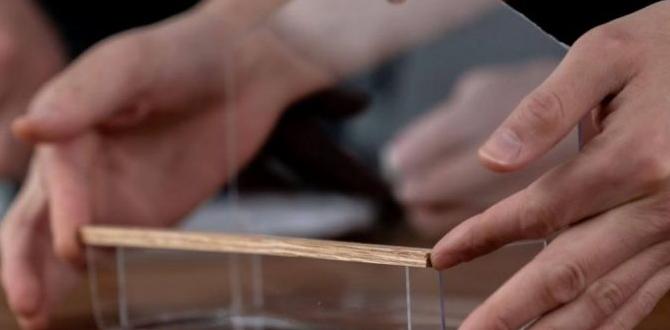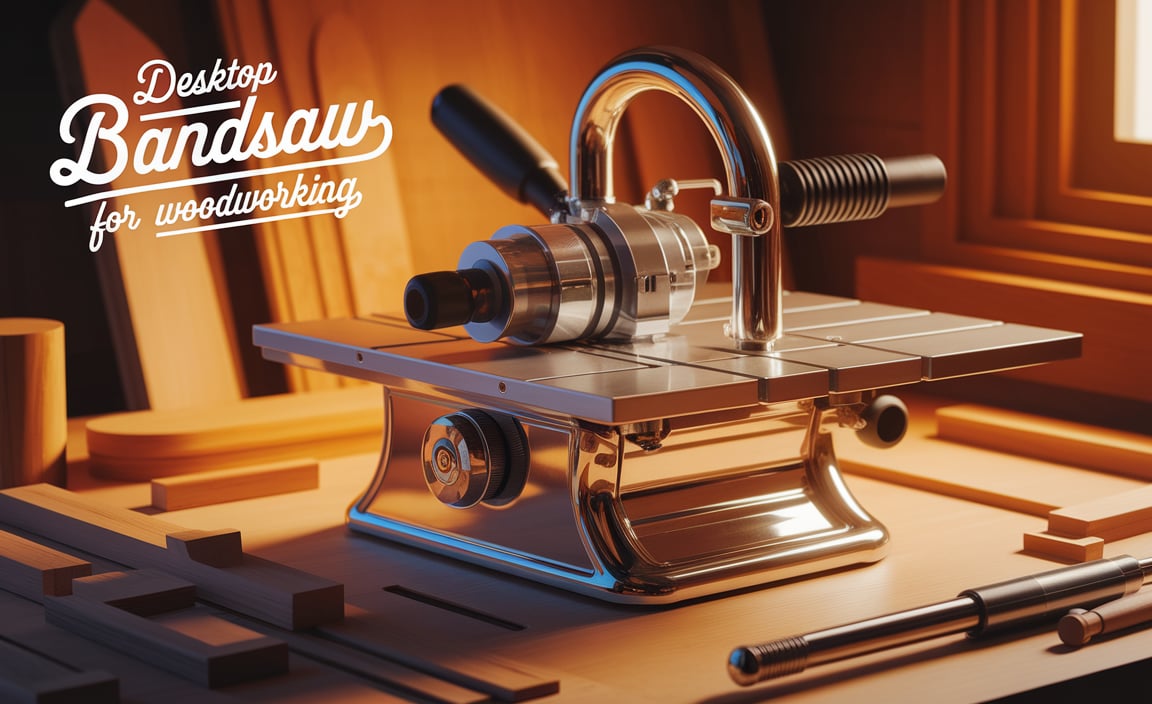Quick Summary:
Replacing a nailer magazine spring is a straightforward fix for feeding issues. Follow these simple steps to install a new spring, ensuring your nailer works flawlessly again. You’ll be back to building in no time!
Hey there, fellow DIYers and wood-loving friends! Jack Shaffer here, your go-to guy for all things nailers. Ever get that frustrating moment when your nailer just stops feeding nails properly? It’s a common problem, and more often than not, the culprit is a worn-out or broken magazine spring. Don’t worry, though! Replacing this little guy is totally doable for anyone, and I’m going to walk you through it, step-by-step. We’ll get your nailer back in action and ready for your next project. Let’s dive in and make sure your tools are always ready to go!
Table of Contents
Why Your Nailer Magazine Spring Needs Replacing
A nailer magazine spring might seem small, but it plays a huge role. Think of it as the hardworking engine that pushes your nails up into the firing chamber. When it’s new and strong, it does this job consistently, allowing you to drive nail after nail without a hitch. You load your nails, and the spring keeps them snug and ready.
However, over time and with lots of use, this spring can weaken. It loses its tension, much like any elastic material that’s been stretched and compressed many times. Sometimes, it can even break. When that happens, the nails won’t be pushed up correctly. You might experience:
- Nails not feeding into the chamber
- Jamming issues
- Inconsistent nail driving
- A general feeling that your nailer just isn’t “gripping” the nails anymore
If you’re noticing any of these symptoms, it’s a pretty good sign that your magazine spring has seen better days. The good news is that this is usually one of the easier and more affordable fixes for nailer trouble. It’s often much cheaper than buying a whole new nailer!
Identifying the Problem: Is It Really the Spring?
Before we jump into replacing the spring, let’s do a quick check to make sure it’s actually the spring that’s causing the problem. Sometimes, other issues can mimic spring failure.
1. Visual Inspection: With the magazine empty and the nailer disconnected from its power source (battery, air hose), look inside the magazine. Can you see the spring? Does it look bent, twisted, or broken? If it’s obviously damaged, you’ve likely found your culprit.
2. Manual Test: Gently try to push the follower (the part that the spring attaches to and that pushes the nails) down. Does it move smoothly? Does it feel excessively loose or overly stiff? If it sticks, there might be debris. If it feels too loose and doesn’t spring back with decent force, the spring is probably the issue.
3. Nail Placement: When you load nails, are they sitting correctly in the magazine? If they’re tilted or not aligned, the spring might not be applying enough or consistent pressure. Empty the magazine and try reseating the nails to see if that makes a difference. If the problem persists even with perfectly loaded nails, it’s more likely the spring.
What else could it be?
- Debris in the magazine: Small wood chips or dust can obstruct the follower. Clear it out thoroughly.
- Damaged magazine: Dents or warping in the magazine itself can cause feeding issues.
- Incorrect nail type/size: Make sure you’re using the nails recommended for your specific nailer model. Check out resources like toolscout.com’s guide on nail gun types for general information, but always defer to your manufacturer’s manual.
If none of these other issues seem to be the cause, then it’s time to focus on that magazine spring.
Tools You’ll Need for the Job
The good news is that you probably have most of these tools already in your home workshop. This is one of those DIY tasks that doesn’t require a specialized or expensive toolkit.
Essential Tools:
- Your Nailer: Of course!
- Replacement Magazine Spring: Make sure you get the correct one for your nailer model.
- Screwdriver Set: You’ll likely need a Phillips head and possibly a flathead.
- Pliers: Needle-nose pliers are often very helpful for grasping small parts.
- Safety Glasses: Always protect your eyes!
- Work Gloves (Optional): To keep your hands clean and protected.
- Small Container or Tray: To keep track of screws and small parts.
- User Manual: Your nailer’s manual is your best friend for specific instructions.
Getting the right replacement spring is crucial. You can usually find these directly from the nailer manufacturer’s website, authorized parts dealers, or sometimes on large online marketplaces. Be sure to identify your nailer’s exact model number to order the correct part. A quick search for “[Your Nailer Brand and Model] magazine spring” should get you started.
Step-by-Step Guide: Replacing Your Nailer Magazine Spring
Alright, let’s get down to business! This process is pretty standard across most pneumatic and many battery-powered nailers. Remember, safety first! Always make sure your nailer is unplugged or the air hose is disconnected before you start.
Step 1: Disconnect Power and Empty the Magazine
This is the most important safety step. If you have a pneumatic (air) nailer, disconnect the air hose. If it’s battery-powered, remove the battery. Then, remove all the nails from the magazine. Make sure there are absolutely no nails left inside.
Step 2: Locate and Remove the Magazine
Most nailer magazines are attached to the front of the tool. Some might have a release lever or button. Others might be held in place by a screw or two that allows the magazine body to separate from the nailer head. Consult your user manual if you’re unsure how to detach the magazine on your specific model. Often, the magazine itself might be in two halves connected by the spring mechanism.
Step 3: Disassemble the Magazine (If Necessary)
This is where things can vary slightly. Some magazines are designed to be easily opened by sliding a cover or a retaining clip. Others might require removing a few small screws. Again, your user manual is key here. Be methodical! Lay out the parts in the order you remove them, or even take pictures with your phone as you go.
You’re typically looking for a follower piece – this is the plastic or metal tab that directly pushes the nails forward. The spring will be attached to this follower, and then usually to a pin or a slot at the other end of the magazine assembly.
Step 4: Remove the Old Spring
Once the magazine is open and you can access the follower and spring assembly, carefully detach the old spring. Sometimes it’s just hooked in place. If it’s bent or broken, it might come out easily. If the spring is still intact but weak, you might need to use your pliers to gently unhook it from the follower or the magazine housing.
Step 5: Install the New Spring
Now for the moment of truth! Take your new replacement spring. Most springs have a hook or a loop on one end that attaches to the follower. Hook this end securely. Then, you’ll need to stretch the spring and attach the other end to its designated spot in the magazine housing. This can sometimes require a bit of force, which is where your trusty pliers can come in handy. Be careful not to overstretch or bend the new spring in the process.
Tip: If the new spring is very stiff, try to get the end closest to the follower attached first. Then, push the follower down as far as it will go, creating slack, and hook the other end of the spring into its slot. It’s a bit like wrangling a stubborn rubber band!
Step 6: Reassemble the Magazine
Carefully put everything back together the way you found it. Make sure the follower slides smoothly along its track. If you removed any screws, re-insert them. Ensure any clips or covers are properly secured. Double-check that no parts are left over!
Step 7: Reattach Magazine and Test
Slide the reassembled magazine back onto your nailer. Reconnect the air hose or battery. Now, load a few nails into the magazine and try firing the nailer into a scrap piece of wood. Does it feed properly? Does the nail drive with good force? Congratulations, you’ve likely just fixed your nailer!
Common Nailer Magazine Spring Issues and How to Solve Them
Even with a step-by-step guide, you might run into a couple of hiccups. Here are some common problems and what to do about them:
1. The New Spring Feels Too Tight or Too Loose
Too Tight: If the follower is extremely difficult to move, you might have accidentally bent or over-stretched the spring during installation. Double-check that it’s seated correctly and that no parts of the magazine itself are obstructing its movement. Sometimes, a slightly tighter spring is better than a loose one, but it shouldn’t be impossible to operate.
Too Loose: If the spring still doesn’t provide enough tension, it might be the wrong spring for your model, or it could genuinely be defective. Ensure you ordered the correct part number. If you’re certain it’s the right part, contact the supplier or manufacturer.
2. Difficulty Hooking the Spring
This is common! The spring needs to be under tension to hook. Use the needle-nose pliers to get a good grip on the end of the spring. You might need to hold the follower in place with one hand (or position it against a stable surface) while you use the pliers to carefully hook the spring with the other. Sometimes, a slight twist with the pliers can help seat the hook properly.
3. Magazine Won’t Reassemble Correctly
If the magazine parts aren’t fitting back together, check if a piece of debris is trapped, or if you’ve put a part in backward or upside down. Take a moment to review the disassembly photos you took or consult the exploded diagram in your manual. Ensure the follower is oriented correctly and that the spring isn’t snagged on anything.
4. Spring Pops Out After Installation
This usually means the spring isn’t seated securely. Make sure the hook or loop on the spring is fully engaged in its slot or on its post in the magazine housing. If the housing has a cover, ensure it’s properly secured and isn’t allowing the spring to pop out.
Nailer Magazine Spring Maintenance Tips
To prevent your new spring from failing prematurely, a little bit of care goes a long way.
- Keep it Clean: After each significant project, or if you notice dust and debris building up, clean out your nailer’s magazine. A blast of compressed air or a soft brush can do wonders. Periodically, you can remove the magazine and give it a more thorough cleaning.
- Use the Right Nails: Always use the correct size and type of nails specified for your nailer. Using incorrect fasteners can cause jams that put undue stress on the spring and other components.
- Store Properly: When not in use, store your nailer in a clean, dry place. Avoid storing it where it could be subjected to heavy impacts or extreme temperatures, which can damage the magazine and its internal parts. Keeping your tools well-maintained is key to their longevity.
- Regular Inspection: Before starting a big project, give your nailer a quick once-over. Check the magazine for any obvious damage or if the follower seems sluggish. It’s easier to fix a small issue before it becomes a major problem.
A well-maintained nailer is a reliable nailer!
Nailer Magazine Spring Types
While the function is the same, magazine springs can vary slightly in design. Understanding these differences can help when you’re ordering a replacement or trying to diagnose a problem.
| Spring Type | Description | Common Application | Potential Issues |
|---|---|---|---|
| Coiled Extension Spring | A standard spring that elongates when pulled. It has hooks or loops on each end to attach to the follower and the magazine housing. | Most common type in pneumatic and many battery nailers (framing, finishing, brad nailers). | Can lose tension over time, break at the hook, or snag if damaged. |
| Flat Spring (Leaf Spring Style) | Less common, these are typically flat pieces of spring steel that flex. They guide the follower. | Found in some older models or specialized nailers. | Can fatigue and break, or become bent. |
| Integrated Spring Systems | Some newer or more compact designs might have springs integrated into the follower assembly or magazine body in a less traditional way. | Compact or specialized battery-powered nailers. | May be harder to source or replace as a separate part; sometimes the whole follower assembly needs replacement. |
For most DIYers, you’ll be dealing with the coiled extension spring. When ordering, ensure you match the length and the strength (gauge of the wire) as closely as possible to the original. If your manual isn’t clear, taking a photo of the old spring and the attachment points can be very helpful when speaking with a parts supplier.
When to Call a Professional (or Consider a New Nailer)
While replacing a nailer magazine spring is a fantastic DIY task, there are a few situations where you might want to reconsider or seek expert help.
- Damaged Magazine Body: If the plastic or metal magazine itself is significantly cracked, bent, or damaged, a new spring won’t fix the underlying problem. In this case, you’ll need to replace the entire magazine assembly, or potentially the tool if the magazine isn’t a separate, replaceable part.
- Complex Disassembly: If your nailer’s magazine seems exceptionally complex to open, with many tiny, specialized parts, and you’re not comfortable with detailed mechanical work, it might be less stressful to take it to a tool repair shop.
- Internal Nailer Damage: If the spring issue is just one symptom of a larger problem within the nailer’s firing mechanism (e.g., bent driver blade, damaged O-rings causing air leaks), then a simple spring replacement won’t solve the core issue.
- Cost vs. Benefit: For very inexpensive nailers, the cost of a replacement spring plus your time might approach the cost of a new, similar-quality nailer. Weigh your options. Sometimes, a new tool is the most economical choice for performance and reliability. For higher-end or specialized nailers, repairing is almost always the better option.
- Safety Concerns: If at any point you feel uncomfortable or unsure about what you’re doing, it’s best to stop. Working with tools, even for adjustments, should be a safe and confident experience. Explore resources like OSHA’s worker safety information to understand general tool safety practices.
Most of the time, a spring replacement is a straightforward win for the DIYer. But knowing when to get help is also part of being a smart tool user!
Frequently Asked Questions (FAQ)
Q1: My nailer is jamming constantly. Could it be the magazine spring?
A1: Yes, it absolutely could be! A weak or broken magazine spring causes nails to not feed properly into the firing chamber, which is a very common cause of jamming. Always check the spring and the follower mechanism first for feeding issues.
Q2: How do I find the part number for my nailer’s magazine spring?
A2: The best way is to consult your nailer’s user manual. It usually has an exploded diagram of the tool with a list of all parts and their corresponding part numbers. If you don’t have the manual, search online for “[Your Nailer Brand and Model] parts diagram” or visit the manufacturer’s support website.
Q3: Can I use a spring from a different nailer if mine is damaged?
A3: It’s not recommended. Springs are designed for specific tension, length, and strength based on the nailer model. Using the wrong spring can lead to poor performance, more jamming, or even damage to the nailer. Always try to get the exact replacement part specified by the manufacturer.
Q4: My nailer magazine is plastic. Can I still replace the spring myself?
A4: Yes! Most plastic nailer magazines are designed for easy maintenance. The process is generally the same as for metal magazines. Just be a bit



